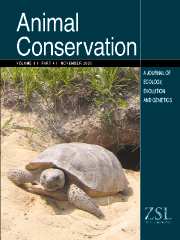Crossref Citations
This article has been cited by the following publications. This list is generated based on data provided by
Crossref.
Arkush, Kristen D
Giese, Alan R
Mendonca, Holly L
McBride, Anne M
Marty, Gary D
and
Hedrick, Philip W
2002.
Resistance to three pathogens in the endangered winter-run chinook salmon (Oncorhynchus tshawytscha): effects of inbreeding and major histocompatibility complex genotypes.
Canadian Journal of Fisheries and Aquatic Sciences,
Vol. 59,
Issue. 6,
p.
966.
Haag, Christoph R.
Sakwińska, Olga
and
Ebert, Dieter
2003.
TEST OF SYNERGISTIC INTERACTION BETWEEN INFECTION AND INBREEDING IN DAPHNIA MAGNA.
Evolution,
Vol. 57,
Issue. 4,
p.
777.
Altizer, Sonia
Harvell, Drew
and
Friedle, Elizabeth
2003.
Rapid evolutionary dynamics and disease threats to biodiversity.
Trends in Ecology & Evolution,
Vol. 18,
Issue. 11,
p.
589.
Haag, Christoph R.
Sakwiska, Olga
and
Ebert, Dieter
2003.
TEST OF SYNERGISTIC INTERACTION BETWEEN INFECTION AND INBREEDING IN DAPHNIA MAGNA.
Evolution,
Vol. 57,
Issue. 4,
p.
777.
Giese, Alan R.
and
Hedrick, Philip W.
2003.
Genetic variation and resistance to a bacterial infection in the endangered Gila topminnow.
Animal Conservation,
Vol. 6,
Issue. 4,
p.
369.
Reid, Jane M.
Arcese, Peter
and
Keller, Lukas F.
2003.
Inbreeding depresses immune response in song sparrows (Melospiza melodia): direct and inter–generational effects.
Proceedings of the Royal Society of London. Series B: Biological Sciences,
Vol. 270,
Issue. 1529,
p.
2151.
Bernatchez, L.
and
Landry, C.
2003.
MHC studies in nonmodel vertebrates: what have we learned about natural selection in 15 years?.
Journal of Evolutionary Biology,
Vol. 16,
Issue. 3,
p.
363.
VAN OOSTERHOUT, C.
HARRIS, P. D.
and
CABLE, J.
2003.
Marked variation in parasite resistance between two wild populations of the Trinidadian guppy, Poecilia reticulata (Pisces: Poeciliidae).
Biological Journal of the Linnean Society,
Vol. 79,
Issue. 4,
p.
645.
COLLYER, MICHAEL L.
and
STOCKWELL, CRAIG A.
2004.
Experimental evidence for costs of parasitism for a threatened species, White Sands pupfish (Cyprinodon tularosa).
Journal of Animal Ecology,
Vol. 73,
Issue. 5,
p.
821.
MØLLER, ANDERS PAPE
and
CASSEY, PHILLIP
2004.
On the relationship between T‐cell mediated immunity in bird species and the establishment success of introduced populations.
Journal of Animal Ecology,
Vol. 73,
Issue. 6,
p.
1035.
Wegner, K. Mathias
Kalbe, Martin
Schaschl, Helmut
and
Reusch, Thorsten B.H.
2004.
Parasites and individual major histocompatibility complex diversity—an optimal choice?.
Microbes and Infection,
Vol. 6,
Issue. 12,
p.
1110.
Sommer, Simone
2005.
The importance of immune gene variability (MHC) in evolutionary ecology and conservation.
Frontiers in Zoology,
Vol. 2,
Issue. 1,
BABIK, W.
DURKA, W.
and
RADWAN, J.
2005.
Sequence diversity of the MHC DRB gene in the Eurasian beaver (Castor fiber).
Molecular Ecology,
Vol. 14,
Issue. 14,
p.
4249.
MEYER‐LUCHT, Y.
and
SOMMER, S.
2005.
MHC diversity and the association to nematode parasitism in the yellow‐necked mouse (Apodemus flavicollis).
Molecular Ecology,
Vol. 14,
Issue. 7,
p.
2233.
Froeschke, Götz
and
Sommer, Simone
2005.
MHC Class II DRB Variability and Parasite Load in the Striped Mouse (Rhabdomys pumilio) in the Southern Kalahari.
Molecular Biology and Evolution,
Vol. 22,
Issue. 5,
p.
1254.
Kristensen, Torsten Nygaard
Sørensen, Peter
Kruhøffer, Mogens
Pedersen, Kamilla Sofie
and
Loeschcke, Volker
2005.
Genome-Wide Analysis on Inbreeding Effects on Gene Expression in Drosophila melanogaster
.
Genetics,
Vol. 171,
Issue. 1,
p.
157.
Schad, J.
Ganzhorn, J. U.
and
Sommer, S.
2005.
PARASITE BURDEN AND CONSTITUTION OF MAJOR HISTOCOMPATIBILITY COMPLEX IN THE MALAGASY MOUSE LEMUR, MICROCEBUS MURINUS.
Evolution,
Vol. 59,
Issue. 2,
p.
439.
Bonneaud, Camille
Richard, Murielle
Faivre, Bruno
Westerdahl, Helena
and
Sorci, Gabriele
2005.
An Mhc class I allele associated to the expression of T-dependent immune response in the house sparrow.
Immunogenetics,
Vol. 57,
Issue. 10,
p.
782.
Schad, J.
Ganzhorn, J. U.
and
Sommer, S.
2005.
PARASITE BURDEN AND CONSTITUTION OF MAJOR HISTOCOMPATIBILITY COMPLEX IN THE MALAGASY MOUSE LEMUR, MICROCEBUS MURINUS.
Evolution,
Vol. 59,
Issue. 2,
p.
439.
CÔTÉ, STEEVE D.
STIEN, AUDUN
IRVINE, R. JUSTIN
DALLAS, JOHN F.
MARSHALL, FREDA
HALVORSEN, ODD
LANGVATN, ROLF
and
ALBON, STEVE D.
2005.
Resistance to abomasal nematodes and individual genetic variability in reindeer.
Molecular Ecology,
Vol. 14,
Issue. 13,
p.
4159.


